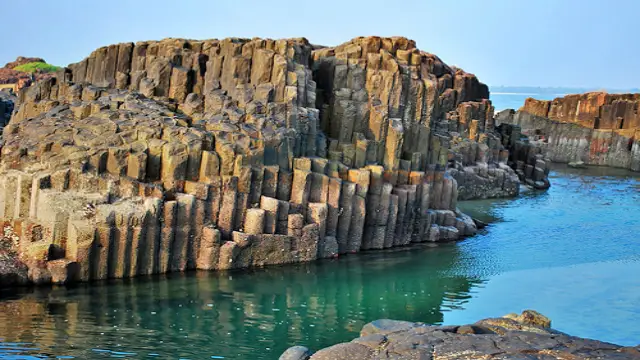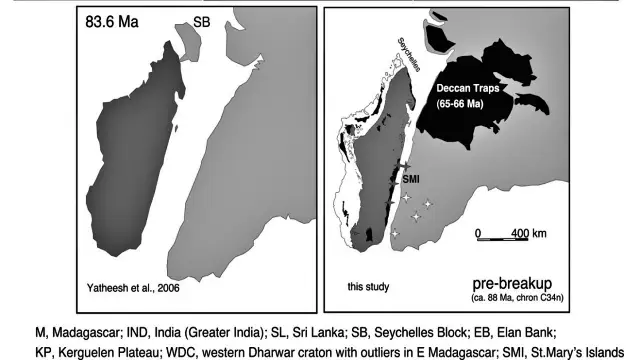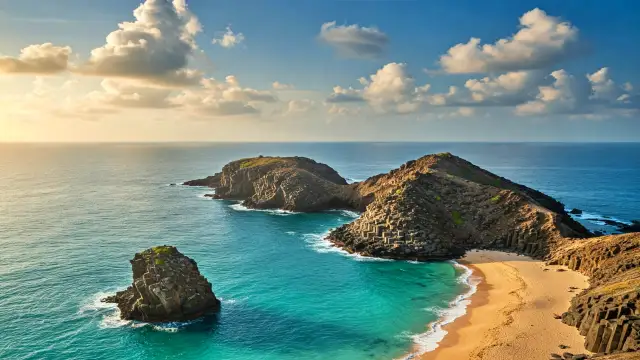Have you ever stumbled upon a place that looks almost too perfect to be natural? Off the coast of Malpe in Karnataka, India, lies St. Mary’s Island, a geological wonder that might just make you question whether nature has a secret penchant for geometry. A short boat ride, typically around Rs. 200 for a round trip with an hour to explore, transports you to this fascinating site where hexagonal rock formations stand tall against the backdrop of the Arabian Sea. These aren’t just any rocks; they are a rare assembly of columnar basaltic structures, seemingly carved with an almost artistic precision. You might find yourself wondering, did some ancient civilization decide to stack these perfectly shaped pillars?

While St. Mary’s Island holds a special place due to its accessibility and the sheer scale of its formations, it’s not the only location on Earth, or even in India, where such geological marvels exist. Within India, similar formations can be found in Kawadia Pahad near Bagli in Madhya Pradesh and the intriguing Gilbert Hill in Andheri, Mumbai, often referred to as India’s Devil’s Tower. Globally, these formations grace landscapes in parts of the USA, the breathtaking Giant’s Causeway in Ireland, and, incredibly, even on Mars, as evidenced by geological surveys. The Geological Survey of India recognized St. Mary’s Island for its unique geological significance, marking it as an important site for geotourism, attracting researchers and enthusiasts alike.
The story of St. Mary’s Island isn’t just etched in stone; it’s intertwined with human history too. In 1498, the famed Portuguese explorer Vasco da Gama first set foot on Indian soil here before continuing his voyage to Calicut, Kozhikode, and Goa. As a gesture of gratitude or perhaps a claim of discovery, he erected a cross on the island and named one of the three small islands joined together ‘O Padrão de Santa Maria’ in honor of Mother Mary. It is from this historical event that the islands derived their present name, St. Mary’s Island.

However, the island’s history stretches far deeper into geological time, connecting it to a landmass that now lies thousands of miles away. Approximately 88 million years ago, the island of Madagascar was not an independent entity floating off the coast of Africa; it was firmly attached to the Indian landmass. As the supercontinent Gondwanaland began its slow but inexorable drift, Madagascar gradually separated from India, eventually reaching its current position. This ancient connection is not just a theory; it’s supported by the remarkable similarity in geological formations found on St. Mary’s Island and in Madagascar. Scientific studies, including the analysis of palaeomagnetic data, strongly suggest that these landmasses were once joined. Different dating techniques, such as Potassium-Argon (K-Ar) and Argon-Argon (Ar-Ar) dating, have established the age of the rocks on St. Mary’s Island to be around 85 to 93 million years old, a timeline that aligns perfectly with the estimated period of the India-Madagascar separation. This deep-time connection underscores the immense geological forces that have shaped our planet over eons.
The striking hexagonal columns that define St. Mary’s Island are a result of a fascinating geological process. These formations arise when molten lava flows cool and contract. India’s Deccan Traps, a vast volcanic region covering parts of Gujarat, Maharashtra, Madhya Pradesh, and Andhra Pradesh, represent one of the Earth’s largest volcanic features. Did you know this massive volcanic activity, which occurred around 66 million years ago, played a significant role in shaping the landscape? However, the formations at St. Mary’s Island predate the main Deccan Traps event, forming approximately 88 million years ago during the initial break-up with Madagascar.
The transformation from flowing lava to these geometric pillars involves a specific sequence. As the lava cools, the edges and the top surface solidify more rapidly than the interior. This faster cooling causes the solidified rock to shrink, exerting a pulling force on the still-molten lava within. This contraction generates tensile stress, leading to the formation of cracks. These cracks, initially appearing on the surface, then propagate downwards into the cooling lava, eventually solidifying to form the distinct columns. While the most common shape observed is hexagonal, variations such as pentagonal or heptagonal columns can also occur, often due to the presence of impurities in the lava or slight differences in the cooling rate. It’s important to note that while many sources refer to “basaltic” lava in the context of columnar jointing, St. Mary’s Islands are specifically composed of rhyolitic lava exhibiting this fascinating phenomenon. This makes the island even more geologically significant, as columnar jointing is less common in rhyolitic compositions.
The prevalence of hexagonal shapes extends far beyond the geology of St. Mary’s Island; it appears throughout the natural world. From the intricate honeycomb built by bees to the delicate structure of snowflakes and the multifaceted eyes of insects, the hexagon seems to be nature’s preferred geometric form. Isn’t it remarkable how bees instinctively construct their honeycombs with such mathematical efficiency, using the least amount of wax to store the maximum amount of honey? This preference for hexagons can be largely attributed to the principle of packing efficiency. Among regular polygons, hexagons allow for the most efficient tiling of a plane, covering the largest area with the shortest perimeter compared to triangles or squares.
Surface tension also plays a crucial role in the formation of hexagonal shapes in phenomena like soap bubbles. When bubbles cluster together, they naturally adopt hexagonal arrangements to minimize their surface area, leading to the characteristic 120-degree angles at their junctions. This principle of efficient stress release is also at play in the cooling lava that formed the columns at St. Mary’s Island. The cracking pattern that develops as the lava contracts is the most efficient way to relieve the internal stresses, naturally leading to the formation of predominantly hexagonal columns. Even seemingly unrelated examples like drying mud puddles or the structure of carbon allotropes like graphite exhibit this fascinating hexagonal tendency.
Beyond the well-established geological and mathematical explanations, some intriguing, though more speculative, ideas connect the hexagonal formations to concepts of frequency and vibration. Nikola Tesla, the brilliant inventor, famously stated that to understand the secrets of the universe, one must think in terms of energy, frequency, and vibration. Did Tesla, with his visionary mind, perhaps glimpse a deeper connection between these fundamental aspects of reality and the geometric patterns we observe in nature? The field of cymatics explores how sound waves can create intricate geometric patterns in various substances, offering a visual representation of the power of vibration.
The 528 Hz frequency, in particular, has garnered attention, with some proponents, like Dr. Leonard Horowitz, claiming it to be a “frequency of love” with the potential for DNA repair and other miraculous effects. While some studies suggest potential stress-reducing effects of music tuned to 528 Hz, the more extraordinary claims lack robust scientific validation. The idea of a specific frequency manifesting hexagonal patterns in cymatics is certainly intriguing, though direct scientific evidence linking 528 Hz specifically to this shape remains limited within the provided material.
Interestingly, the hexagonal shape appears not only in terrestrial geology but also on a cosmic scale. Saturn’s North Pole features a massive, persistent storm system shaped like a hexagon. Discovered by the Voyager mission and extensively studied by Cassini, this enormous atmospheric phenomenon, large enough to fit four Earths, is a jet stream moving at incredible speeds. Unlike the solid rock formations of St. Mary’s Island, Saturn’s hexagon is a dynamic weather pattern. Current scientific theories suggest its formation is due to differences in wind speeds at various latitudes creating stable standing wave patterns in the planet’s atmosphere. While the exact mechanisms maintaining its sharp edges and longevity are still under investigation, the existence of this cosmic hexagon serves as a powerful reminder that this geometric shape arises in diverse natural contexts, from cooling lava to planetary atmospheres.
In conclusion, St. Mary’s Island stands as a remarkable testament to the power and beauty of geological processes. Its unique hexagonal columnar rhyolite formations, a direct consequence of ancient volcanic activity linked to the separation of India and Madagascar, offer a tangible glimpse into Earth’s dynamic past. The prevalence of the hexagonal shape, not just on this island but across a multitude of natural phenomena, underscores fundamental principles of efficiency and stability in the universe. While the more speculative connections to frequency and vibration add an element of mystery, the scientific explanations grounded in geology, mathematics, and physics provide a solid framework for understanding this extraordinary natural wonder. St. Mary’s Island remains a significant geological monument, a place where the perfect geometry of nature is on full, stunning display.



